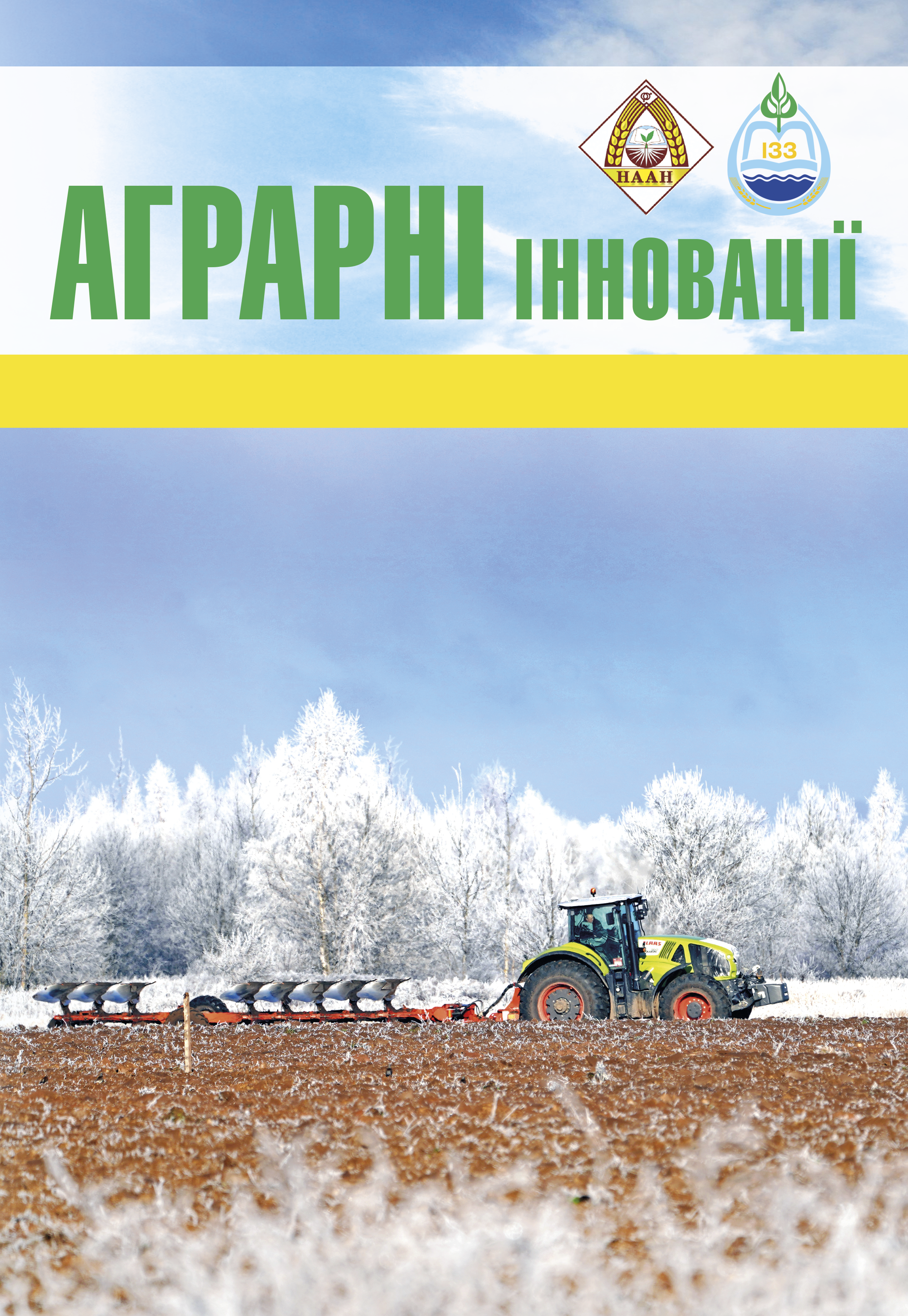Normalized difference vegetation index as a marker of winter crops identification in the systems of automated crops mapping
Abstract
Purpose. Studying the possibility of using the time series of satellite normalized difference vegetation index and discriminant canonical function for the classification of winter crops (wheat, barley, rapeseed) for further automated crops mapping. Methods. Data on the time series of normalized difference vegetation index for 2018 in the period “April – July”, obtained for 70 randomly selected fields of winter wheat, winter barley and winter rapeseed (210 fields in total), located in the Steppe zone of Ukraine, were used for performing multiclass linear discriminant analysis and canonical discriminant analysis. According to the results of mathematical and statistical processing of the data, a discriminant function for the classification of each studied crop was developed. Statistical calculations were performed at a confidence level of 95% (P<0.05). Results. According to the results of mathematical and statistical calculations, two canonical functions were developed, and the assessment of the weight of each of them in achieving correct results proved the superiority of the first (82.9% vs. 17.1%; canonical correlation coefficient 0.78 vs. 0.49, respectively). The calculated coefficients and constants made it possible to develop a canonical classification function for identifying the studied crops. The best classification accuracy was recorded for winter wheat (75.7%) and winter barley (72.9%), while winter rapeseed was identified the worst – the prediction accuracy was 55.7%. This can be put upon the distortion of the NDVI of winter rapeseed crops during the stage of full flowering of the crop. Automated mapping of winter crops based on the developed canonical discriminant function is possible for the cereals and remains questionable for rapeseed. Conclusions. The results of the study proved the possibility of highly accurate classification and subsequent mapping of winter cereals based on the time series data of normalized difference vegetation index. The classification of winter rapeseed requires additional research involving alternative algorithms and methods.
References
2. Sishodia R. P., Ray R. L., Singh S. K. Applications of remote sensing in precision agriculture: A review. Remote Sensing. 2020. Vol. 12. No. 19. P. 3136. DOI: 10.3390/rs12193136
3. Сердюченко Н. (Аналіз систем агромоніторингу транснаціонального рівня. Техніко-технологічні аспекти розвитку та випробування нової техніки і технологій для сільського господарства України. 2018. Вип. 22. С. 159 –165.
4. Bellón B., Bégué A., Lo Seen D., De Almeida C. A., Simões M. A remote sensing approach for regionalscale mapping of agricultural land-use systems based on NDVI time series. Remote Sensing. 2017. Vol. 9. No. 6. P. 600. DOI: 10.3390/rs9060600
5. Kuenzer C., Knauer K. Remote sensing of rice crop areas. International Journal of Remote Sensing. 2013. Vol. 34. No. 6. P. 2101–2139. DOI: 10.1080/01431161.2012.738946
6. Kussul N., Lavreniuk M., Skakun S., Shelestov A. Deep learning classification of land cover and crop types using remote sensing data. IEEE Geoscience and Remote Sensing Letters. 2017. Vol. 14. No. 5. P. 778–782. DOI: 10.1109/LGRS.2017.2681128
7. Kussul N., Skakun S., Shelestov A., Lavreniuk M., Yailymov B., Kussul O. Regional scale crop mapping using multi-temporal satellite imagery. The International Archives of the Photogrammetry, Remote Sensing and Spatial Information Sciences. 2015. Vol. 40. P. 45–52. DOI: 10.5194/isprsarchives-XL-7-W3-45-2015
8. Zhang C., Di L., Lin L., Li H., Guo L., Yang Z., Yu E. G., Di Y., & Yang A. Towards automation of in-season crop type mapping using spatiotemporal crop information and remote sensing data. Agricultural Systems. 2022. Vol. 201. P. 103462. DOI: 10.1016/j.agsy.2022.103462
9. Tariq A., Yan J., Gagnon A. S., Riaz Khan M., Mumtaz F. Mapping of cropland, cropping patterns and crop types by combining optical remote sensing images with decision tree classifier and random forest. Geo-Spatial Information Science. 2023. Vol. 26. No. 3. P. 302–320. DOI: 10.1080/10095020.2022.2100287
10. López-Granados, F., Gómez-Casero, M. T., Pena-Barragán, J. M., Jurado-Expósito, M., & Garcia-Torres, L. (2010). Classifying irrigated crops as affected by phenological stage using discriminant analysis and neural networks. Journal of the American Society for Horticultural Science, 135(5), 465–473. DOI: 10.21273/JASHS.135.5.465
11. Lykhovyd P. V. Using normalised difference vegetation index in classification and agroecological zoning of spring row crops. Biosystems Diversity. 2023. Vol. 31. No. 4. P. 506–512. DOI:10.15421/012360
12. Lykhovyd P. V. Seasonal dynamics of normalized difference vegetation index in some winter and spring crops in the South of Ukraine. Agrology. 2021. Vol. 4. No. 4. P. 187–193. DOI: 10.32819/021022
13. Cruz-Castillo J. G., Ganeshanandam S., MacKay B. R., Lawes G. S., Lawoko C. R. O., Woolley D. J. Applications of canonical discriminant analysis in horticultural research. HortScience. 1994. Vol. 29. No. 10. P. 1115–1119.
14. Li T., Zhu S., Ogihara M. Using discriminant analysis for multi-class classification: an experimental investigation. Knowledge and Information Systems. 2006. Vol. 10. P. 453–472. DOI: 10.1007/s10115-006-0013-y
15. Карташов М. В. Імовірність, процеси, статистика. Київ : ВПЦ Київський університет, 2007. 504 с.
16. Zang Y., Chen X., Chen J., Tian Y., Shi Y., Cao X., Cui X. Remote sensing index for mapping canola flowers using MODIS data. Remote Sensing. 2020. Vol. 12. No. 23. P. 3912. DOI: 10.3390/rs12233912






